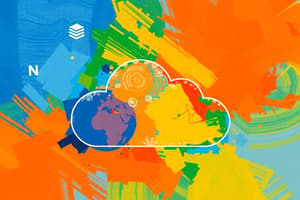Podcast
Questions and Answers
Which aspect of cloud computing allows users to obtain resources without human assistance?
Which aspect of cloud computing allows users to obtain resources without human assistance?
- On-demand self service (correct)
- Measured services
- Broad network access
- Resource pooling
What does rapid elasticity in cloud computing entail?
What does rapid elasticity in cloud computing entail?
- Fixed resource allocation
- Temporary service outages
- Shrink and grow capabilities (correct)
- Sustained resource availability
How does resource pooling benefit cloud computing services?
How does resource pooling benefit cloud computing services?
- It enhances individual resource ownership.
- It eliminates the need for network access.
- It dynamically assigns resources based on demand. (correct)
- It provides fixed resources for each user.
Which characteristic ensures that cloud services can be accessed from various devices?
Which characteristic ensures that cloud services can be accessed from various devices?
What is the significance of measured services in cloud computing?
What is the significance of measured services in cloud computing?
What is a primary advantage of Software-as-a-Service (SaaS)?
What is a primary advantage of Software-as-a-Service (SaaS)?
Which cloud service model primarily targets application developers?
Which cloud service model primarily targets application developers?
What is a common disadvantage associated with Platform-as-a-Service (PaaS)?
What is a common disadvantage associated with Platform-as-a-Service (PaaS)?
What distinguishes Cloud computing from earlier computing models?
What distinguishes Cloud computing from earlier computing models?
What is a significant disadvantage of using Software-as-a-Service (SaaS)?
What is a significant disadvantage of using Software-as-a-Service (SaaS)?
Which was the first major cloud service to be widely utilized?
Which was the first major cloud service to be widely utilized?
When referring to Infrastructure-as-a-Service (IaaS), which of the following components is typically included?
When referring to Infrastructure-as-a-Service (IaaS), which of the following components is typically included?
What is the primary target audience for Software-as-a-Service (SaaS)?
What is the primary target audience for Software-as-a-Service (SaaS)?
What is a key technology that facilitates Cloud computing?
What is a key technology that facilitates Cloud computing?
Which of the following best describes a method to handle many users in a Cloud application?
Which of the following best describes a method to handle many users in a Cloud application?
What is a tradeoff commonly considered in Cloud database management?
What is a tradeoff commonly considered in Cloud database management?
Which term refers to the independent services within a Cloud application architecture?
Which term refers to the independent services within a Cloud application architecture?
What term describes the process of managing multiple users' data in Cloud applications?
What term describes the process of managing multiple users' data in Cloud applications?
What is one advanced topic in IaaS systems management?
What is one advanced topic in IaaS systems management?
What distinguishes OS-level virtualization from machine virtualization?
What distinguishes OS-level virtualization from machine virtualization?
What can be a consequence of a traditional single-machine application in the Cloud?
What can be a consequence of a traditional single-machine application in the Cloud?
Which country has the highest electricity consumption in billion kWh?
Which country has the highest electricity consumption in billion kWh?
What is the rank of the global IT sector in terms of electricity demand compared to countries?
What is the rank of the global IT sector in terms of electricity demand compared to countries?
Which area of electricity consumption does not exceed that of the IT sector?
Which area of electricity consumption does not exceed that of the IT sector?
What aspect has historically dominated the electricity consumption in the IT sector?
What aspect has historically dominated the electricity consumption in the IT sector?
Which country has a lower electricity consumption than the IT sector?
Which country has a lower electricity consumption than the IT sector?
What percentage of global IT sector electricity demand is heavily dependent on coal?
What percentage of global IT sector electricity demand is heavily dependent on coal?
What factor has contributed to smaller and more energy-efficient personal electronic devices?
What factor has contributed to smaller and more energy-efficient personal electronic devices?
What was the total electricity consumption of the IT sector in 2012?
What was the total electricity consumption of the IT sector in 2012?
What does IaaS primarily provide?
What does IaaS primarily provide?
What is a disadvantage of using IaaS?
What is a disadvantage of using IaaS?
Which cloud deployment model is characterized by services rendered on a third-party data center?
Which cloud deployment model is characterized by services rendered on a third-party data center?
What is a characteristic of Private Clouds?
What is a characteristic of Private Clouds?
What is a primary concern for businesses using Public Clouds?
What is a primary concern for businesses using Public Clouds?
What type of virtualization does IaaS potentially use when deploying virtual machines?
What type of virtualization does IaaS potentially use when deploying virtual machines?
What type of user primarily targets IaaS resources?
What type of user primarily targets IaaS resources?
Which of the following is NOT an advantage of using a Private Cloud?
Which of the following is NOT an advantage of using a Private Cloud?
What percentage of global electricity consumption was accounted for by the IT sector in 2012?
What percentage of global electricity consumption was accounted for by the IT sector in 2012?
By what percentage is the IT sector projected to grow its electricity consumption annually through 2030?
By what percentage is the IT sector projected to grow its electricity consumption annually through 2030?
Which of the following was NOT a main component of electricity consumption for the IT sector in 2012?
Which of the following was NOT a main component of electricity consumption for the IT sector in 2012?
What was the percentage of electricity consumption by Data Centers in 2017?
What was the percentage of electricity consumption by Data Centers in 2017?
How much of the IT sector's electricity consumption was associated with Devices in 2012?
How much of the IT sector's electricity consumption was associated with Devices in 2012?
What was the overall trend in electricity consumption for the IT sector from 2012 to 2017?
What was the overall trend in electricity consumption for the IT sector from 2012 to 2017?
As of 2017, what was the percentage of electricity consumed by Networks in the IT sector?
As of 2017, what was the percentage of electricity consumed by Networks in the IT sector?
What percentage of the total electricity consumption did Manufacturing represent in the IT sector in 2012?
What percentage of the total electricity consumption did Manufacturing represent in the IT sector in 2012?
Which statement describes the growth rate of electricity demand in the IT sector compared to the global average?
Which statement describes the growth rate of electricity demand in the IT sector compared to the global average?
What was the projected percentage of global electricity consumption by the IT sector by 2017?
What was the projected percentage of global electricity consumption by the IT sector by 2017?
Flashcards
Cloud Computing
Cloud Computing
Computing services delivered over the internet, allowing users to access resources and services as needed.
Cloud Delivery Model
Cloud Delivery Model
A model for delivering computing services as externalized resources over the internet.
On-Demand Self Service
On-Demand Self Service
The ability to access resources and services without human intervention, making it convenient and scalable.
Broad Network Access
Broad Network Access
Signup and view all the flashcards
Resource Pooling
Resource Pooling
Signup and view all the flashcards
Platform-as-a-Service (PaaS)
Platform-as-a-Service (PaaS)
Signup and view all the flashcards
Infrastructure-as-a-Service (IaaS)
Infrastructure-as-a-Service (IaaS)
Signup and view all the flashcards
Software-as-a-Service (SaaS)
Software-as-a-Service (SaaS)
Signup and view all the flashcards
Rapid Elasticity
Rapid Elasticity
Signup and view all the flashcards
Cloud Application
Cloud Application
Signup and view all the flashcards
VM Deployment
VM Deployment
Signup and view all the flashcards
Containerization
Containerization
Signup and view all the flashcards
Public Cloud
Public Cloud
Signup and view all the flashcards
Private Cloud
Private Cloud
Signup and view all the flashcards
Hybrid Cloud
Hybrid Cloud
Signup and view all the flashcards
Hypervisor
Hypervisor
Signup and view all the flashcards
IT sector electricity consumption
IT sector electricity consumption
Signup and view all the flashcards
IT Manufacturing energy consumption
IT Manufacturing energy consumption
Signup and view all the flashcards
Energy consumption in data centers
Energy consumption in data centers
Signup and view all the flashcards
Energy consumption in computer networks
Energy consumption in computer networks
Signup and view all the flashcards
Energy consumption for personal devices
Energy consumption for personal devices
Signup and view all the flashcards
IT sector as a large energy consumer
IT sector as a large energy consumer
Signup and view all the flashcards
Shifting focus of energy consumption in the IT sector
Shifting focus of energy consumption in the IT sector
Signup and view all the flashcards
China's role in IT sector's carbon footprint
China's role in IT sector's carbon footprint
Signup and view all the flashcards
IT sector's future electricity consumption
IT sector's future electricity consumption
Signup and view all the flashcards
Growth rate of IT electricity consumption
Growth rate of IT electricity consumption
Signup and view all the flashcards
Electricity consumption by devices
Electricity consumption by devices
Signup and view all the flashcards
Electricity consumption by networks
Electricity consumption by networks
Signup and view all the flashcards
Electricity consumption by data centers
Electricity consumption by data centers
Signup and view all the flashcards
Electricity consumption in IT manufacturing
Electricity consumption in IT manufacturing
Signup and view all the flashcards
Main components of IT energy consumption
Main components of IT energy consumption
Signup and view all the flashcards
Energy consumption shift towards networks and data centers
Energy consumption shift towards networks and data centers
Signup and view all the flashcards
Future trends in IT energy consumption
Future trends in IT energy consumption
Signup and view all the flashcards
What is virtualization?
What is virtualization?
Signup and view all the flashcards
What is machine virtualization?
What is machine virtualization?
Signup and view all the flashcards
What is containerization?
What is containerization?
Signup and view all the flashcards
How do you build a scalable application in the cloud?
How do you build a scalable application in the cloud?
Signup and view all the flashcards
What are microservices?
What are microservices?
Signup and view all the flashcards
What is serverless computing?
What is serverless computing?
Signup and view all the flashcards
How do cloud databases handle large amounts of data?
How do cloud databases handle large amounts of data?
Signup and view all the flashcards
What is big data processing in cloud computing?
What is big data processing in cloud computing?
Signup and view all the flashcards
Study Notes
Course Information
- Course Title: Cloud Computing
- Course Code: LINFO2145
- Instructor: Pr. Etienne Rivière
- Email: [email protected]
- University: UCL (Université catholique de Louvain)
What is Cloud Computing?
- Brainstorm keywords associated with cloud computing (technologies, methods, concepts, etc.)
- Limit keywords to 18 characters
- Vote on existing proposals or suggest new ones
- Participation link: https://app.wooclap.com/NIEBPN
- Alternative participation method: Send @LHFXQN to 0460 200 711
Cloud Computing: A Definition
- Computing services provided remotely over the internet
- A delivery model
- Diverse range of scenarios
Possible NIST Definition
- On-demand self-service: Access resources without human interaction
- Broad network access: Access via various devices (mobile, laptops, tablets, workstations)
- Resource pooling: Dynamic assignment of physical and virtual resources based on demand
- Rapid elasticity: Scalable capacity increases and decreases.
- Measured services: Transparent monitoring, control, and reporting of resource usage
Journey to the Cloud
- Timeline highlighting key developments in cloud computing:
- 1980s - Early Infrastructure
- 1990s - Grid computing emergence
- 2000s - Utility computing, Software-as-a-Service (SaaS), salesforces.com
- 2006 - Amazon Web Services (AWS)
- 2010 - Rise of Cloud computing, web 2.0
- This timeline highlights how cloud computing developed over time.
Cloud Service Models (SPI)
- SaaS (Software as a Service): Hosted applications (e.g., Gmail, Salesforce, Office 365, zoom, Overleaf)
- Advantages: ease of use and little administration
- Disadvantages: vendor lock-in, high costs
- Target: end users
- PaaS (Platform as a Service): Managed operating system, support services, environments (e.g., Heroku, Google App Engine, Microsoft Azure, amazon web services™)
- Advantages: focus on development
- Disadvantages: platform lock-in when the application scales
- Target: application developers
- IaaS (Infrastructure as a Service): Hosting of servers, resources (e.g., IBM SmartCloud, Rackspace, Amazon EC2, Google Compute Engine)
- Advantages: flexibility, full control, privacy
- Disadvantages: maintenance and complexity
- Target: IT infrastructure managers and developers
Cloud Deployment Models
- Public Cloud: Infrastructure owned by a third-party on a public network (e.g., Amazon, Rackspace)
- Advantages: Cost-effectiveness, no maintenance
- Disadvantages: Security and privacy risks
- Private Cloud: Infrastructure hosted by a single organization (e.g., for internal use within an organization)
- Advantages: Security, Control of infrastructure and sensitive data
- Disadvantages: Cost of maintenance, potential for underutilization
- Hybrid Cloud: Combination of private and public cloud infrastructure.
- Advantages: combines the security of private with accessibility of public cloud
- Disadvantages: operational/integration complexity
- Diagram illustrates these models.
Cloud Infrastructure: Data Centers
- Cloud infrastructure is housed in data centers.
- Large-scale computing facilities. Key players in the market include AWS, Microsoft, Azure, Google, Meta, Apple. -Diagram displays major providers.
Energy Impact
- Charts show electricity consumption trends in the IT sector over time (2012, 2017).
- Electricity consumption is presented as a country.
Course Overview
- Learning objectives for the course.
- Programming large applications
- Understanding software engineering
- Cloud resource and infrastructure management
- Handling massive user bases efficiently
- Handling massive data usage efficiently
Part A: Enabling Technologies
- Virtualization is a key technology in cloud computing for the sharing of physical resources among multiple users.
- Machine virtualization
- OS-level virtualization (containers)
- Topics include virtualization, machine management and operating system management from various application management.
Part B: Building Scalable Applications
- How to create apps that scale in the cloud efficiently
- Collections of small independent services (micro-services)
- Replicable services
- Scalable cloud-based databases
- Replicating data for availability
Part C: Big Data Processing
- Analyzing user generated data (history, mobile data, usage)
- Derive value from the data
- New paradigms for data processing (volume, velocity)
Advanced Topics
- Building fault-tolerant cloud services and applications
- Cloud DevOps practices
- Addressing security and privacy in cloud computing
- Blockchains and decentralization in cloud environments
Practical Information
- Course schedule (lectures, practical sessions)
- Contact information for instructors and assistants
- The course uses Moodle to share course materials
Semester Project
- Web store design and implementation, focused on cloud backend development
- Implementing features leveraging big data processing
- Teamwork required, projects done in pairs.
Tutorials
- Tutorials available, support the project development.
- Tutorials for bootstrapping
- using virtual machines
- using Docker containers
- Cloud databases, and how to use Kubernetes
- Tutorials are not graded.
- Participants can work alone or in groups of two.
Online Quizzes
- Quizzes on Moodle every 1-2 weeks
- Quizzes cover lecture and practical sessions
- Peer-review process for graded quizzes
- Quizzes contribute 10% of the mark
Grading and Evaluation
- First session projects count for 45%, final exams for 45% quizzes for 10%.
- Second session projects count for 45%, final exams for 55%, no quizzes.
General Comments
- Encourage feedback from learners
- Issues with tutorials should be reported early
- Active participation in the course is encouraged
###GitHub
- Tutorials and starter code for the course project will be on GitHub
- Requires students to create a private GitHub repositories.
- Students use GitHub for managing project code
- Students are expected to provide their GitHub identifiers/links via the course Moodle platform.
- Real names are also required.
Studying That Suits You
Use AI to generate personalized quizzes and flashcards to suit your learning preferences.



